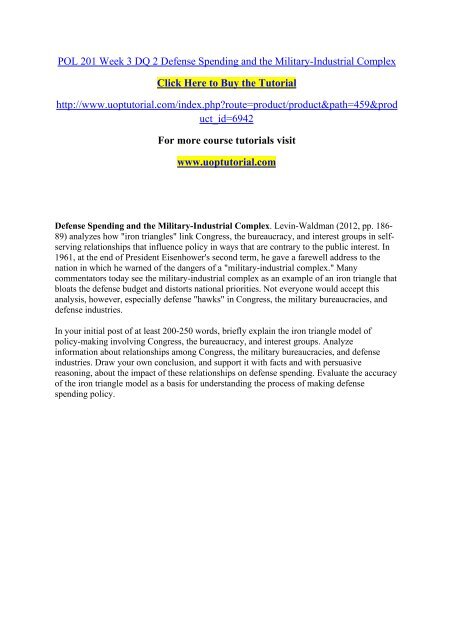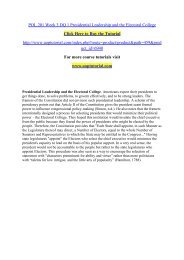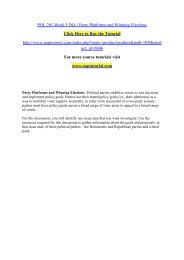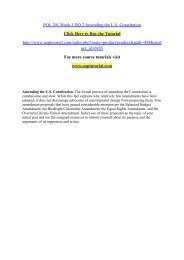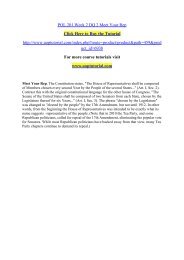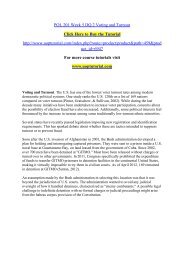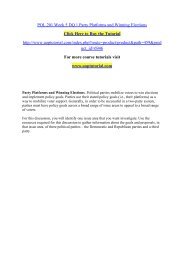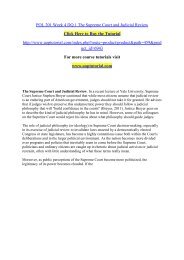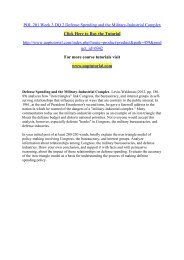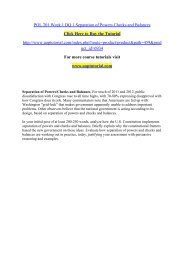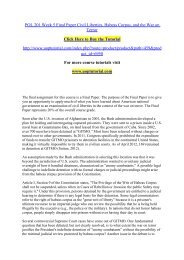POL 201 Week 3 DQ 2 Defense Spending and the Military/ Uoptutorial
For more course tutorials visit www.uoptutorial.com Defense Spending and the Military-Industrial Complex. Levin-Waldman (2012, pp. 186-89) analyzes how "iron triangles" link Congress, the bureaucracy, and interest groups in self-serving relationships that influence policy in ways that are contrary to the public interest. In 1961, at the end of President Eisenhower's second term, he gave a farewell address to the nation in which he warned of the dangers of a "military-industrial complex." Many commentators today see the military-industrial complex as an example of an iron triangle that bloats the defense budget and distorts national priorities. Not everyone would accept this analysis, however, especially defense "hawks" in Congress, the military bureaucracies, and defense industries.
For more course tutorials visit
www.uoptutorial.com
Defense Spending and the Military-Industrial Complex. Levin-Waldman (2012, pp. 186-89) analyzes how "iron triangles" link Congress, the bureaucracy, and interest groups in self-serving relationships that influence policy in ways that are contrary to the public interest. In 1961, at the end of President Eisenhower's second term, he gave a farewell address to the nation in which he warned of the dangers of a "military-industrial complex." Many commentators today see the military-industrial complex as an example of an iron triangle that bloats the defense budget and distorts national priorities. Not everyone would accept this analysis, however, especially defense "hawks" in Congress, the military bureaucracies, and defense industries.
- No tags were found...
You also want an ePaper? Increase the reach of your titles
YUMPU automatically turns print PDFs into web optimized ePapers that Google loves.
<strong>POL</strong> <strong>201</strong> <strong>Week</strong> 3 <strong>DQ</strong> 2 <strong>Defense</strong> <strong>Spending</strong> <strong>and</strong> <strong>the</strong> <strong>Military</strong>-Industrial ComplexClick Here to Buy <strong>the</strong> Tutorialhttp://www.uoptutorial.com/index.php?route=product/product&path=459&product_id=6942For more course tutorials visitwww.uoptutorial.com<strong>Defense</strong> <strong>Spending</strong> <strong>and</strong> <strong>the</strong> <strong>Military</strong>-Industrial Complex. Levin-Waldman (<strong>201</strong>2, pp. 186-89) analyzes how "iron triangles" link Congress, <strong>the</strong> bureaucracy, <strong>and</strong> interest groups in selfservingrelationships that influence policy in ways that are contrary to <strong>the</strong> public interest. In1961, at <strong>the</strong> end of President Eisenhower's second term, he gave a farewell address to <strong>the</strong>nation in which he warned of <strong>the</strong> dangers of a "military-industrial complex." Manycommentators today see <strong>the</strong> military-industrial complex as an example of an iron triangle thatbloats <strong>the</strong> defense budget <strong>and</strong> distorts national priorities. Not everyone would accept thisanalysis, however, especially defense "hawks" in Congress, <strong>the</strong> military bureaucracies, <strong>and</strong>defense industries.In your initial post of at least 200-250 words, briefly explain <strong>the</strong> iron triangle model ofpolicy-making involving Congress, <strong>the</strong> bureaucracy, <strong>and</strong> interest groups. Analyzeinformation about relationships among Congress, <strong>the</strong> military bureaucracies, <strong>and</strong> defenseindustries. Draw your own conclusion, <strong>and</strong> support it with facts <strong>and</strong> with persuasivereasoning, about <strong>the</strong> impact of <strong>the</strong>se relationships on defense spending. Evaluate <strong>the</strong> accuracyof <strong>the</strong> iron triangle model as a basis for underst<strong>and</strong>ing <strong>the</strong> process of making defensespending policy.


